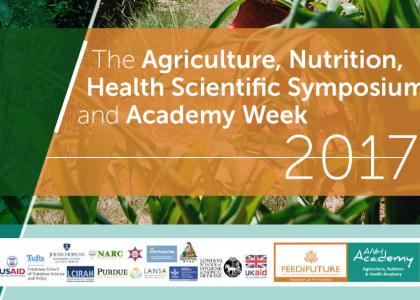
10 minute abstract-driven presentations.
Speakers and Presentations:
Chair: Binjwala Shrestha, IOM
-
Haris Gazdar, LANSA, Pakistan
The relationship between crop-related agricultural workload and maternal and infant nutritional status in rural Pakistan: the LANSA project
Slides / Recording -
Erin Lentz, University of Texas- Austin, USA
Qualitative findings on the Women's Empowerment in Nutrition Index
Slides / Recording -
Poshan Dahal, Tufts University, Nepal
Effect of male out-migration on household food security: Evidence from a mixed methods study in Far West Nepal -
Helen Harris- Fry, LSHTM, UK
Food security does not lead to equity: a study on intrahousehold food allocation in rural Nepal.
Slides / Recording
Abstracts:
The relationship between crop-related agricultural workload and maternal and infant nutritional status in rural Pakistan: the LANSA project.
Haris Gazdar, LANSA, Pakistan
Introduction: The nutritional status of women of reproductive age and infants is poor in rural Pakistan. The agricultural workforce is also becoming increasingly feminised, with 75% of women employed in agricultural labour. Agricultural work, for women, often involves working long hours performing manual labour in the field. The impact of women’s agricultural work conducted during pregnancy on maternal and early infancy nutritional status is not known in this setting. Thus, this study aimed to examine the relationship between crop-related agricultural activities during pregnancy, maternal body mass index (BMI) and infant growth.
Methods: A cross-sectional survey of a representative sample of rural mother-infant dyads was conducted in Sindh province from January to February 2016. Infants were 2- 12 weeks of age. Interviewer-administered questionnaires and maternal and infant anthropometric measurements (weight and height/length) were collected. The primary outcomes were maternal body mass index measured post-pregnancy (BMI; n=1146) and infant length-for-age zscore (HAZ; n=1143). Crop-related agricultural activities measured included sowing, transplanting, digging, weeding, applying fertilizer, grain and vegetable harvesting, and cotton picking. A binary variable was created for any crop-related agricultural activities done during pregnancy. Cotton picking was also independently examined given the long hours and high intensity of the work. Hypothesized modelled pathways from crop-related agriculture activities to maternal BMI and infant growth were created based on the literature and drawn as directed acyclic graphs (DAGs). Associations between crop-related agricultural activities (i.e. any crop-related activities or cotton picking) and maternal BMI and infant HAZ were examined using multivariate linear regression analysis; adjusting for variables identified as confounders in the DAGs. Structural-equation based modelling was also used to test whether maternal BMI mediated the association between crop-related agricultural activities and infant growth.
Findings and Interpretations: The median [IQR] BMI of women and HAZ of infants were 20.5 [18.7, 22. 6] and -1.82 [-2.7; -0.9], respectively. Overall, 21.6% of women were underweight and 45.3% of the infants were stunted. Among the women, 43% reported doing crop-related agricultural activities during pregnancy of which 29% were involved in cotton-picking. Crop-related agricultural workload and cotton-picking were both negatively associated with maternal BMI after adjusting for potential confounders (β=-0.97 [-1.51; -0.48] for any crop-related agricultural work and β=-0.87 [-1.33; -0.45] for cotton-picking). Among infants, both crop-related agricultural work and cotton-picking were negatively associated with HAZ, but this negative association remained significant for only cotton-picking in the multivariable analysis (β=-0.34 [-0.54; -0.13]). Given evidence that cotton picking was negatively associated with both maternal BMI and infant HAZ, structural equation based modelling was used to test whether the relationship between cotton-picking and infant growth was mediated via maternal BMI. These results showed that cotton picking had a direct effect of -0.29 [-0.47; - 0.10] on infant HAZ and an indirect effect of -0.05 [-0.09; - 0.02] via maternal BMI with a total effect of -0.35 [-0.53; - 0.16]. This suggests that 14% (-0.05/-0.35) of the relationship between cotton-picking and HAZ is mediated via maternal BMI.
Conclusions: This study has generated new and critical evidence on the linkages between maternal agricultural workload and maternal and infant nutrition in a sample of mother-infant dyads living in rural Sindh. The high prevalence of low maternal BMI and stunting in early infancy is a public health concern. Crop-related agricultural work during Page | 59 pregnancy, especially cotton-picking, was associated with poor maternal and early infancy nutritional status, even after controlling for confounders such as household wealth and education. The results of this study underscore the need to reduce agricultural workload demands during pregnancy to improve maternal and infant nutritional status. Our findings highlight the difficult trade-off faced by poor rural women whose work in agriculture is driven by the need to support household consumption in the first place. Pakistan’s economy relies on the agriculture sector. Given that both commercialisation of agriculture and women’s involvement in agriculture are increasing, results from this study suggest the government should invest in women and their working conditions to improve the long-term health and nutritional status of its rural population. Policies and programmes in agriculture, nutrition and social protection in Pakistan are yet to be attentive to the needs of vulnerable groups such as female agricultural workers.
Qualitative findings on the Women's Empowerment in Nutrition Index
Erin Lentz, University of Texas- Austin, USA
Introduction: To better understand the role of women in mediating agriculture to nutrition linkages, we develop the concept of nutritional empowerment. We use the lens of nutritional empowerment to assess how women make nutritional decisions and how their ability to make decisions differs across nutritional drivers such as health, food purchases, home production, water and sanitation, and care practices. In this study, we collect and analyze qualitative interviews from three sites in rural South Asia to identify the drivers of women’s nutritional empowerment across multiple domains of nutrition. We also identify socio-cultural conditions that do or do not support nutrition.
Methods: To better understand the constraints that rural South Asian women themselves identify as important for their nutrition, we collaborated with rural civil society members, training them to become community researchers. In each rural agrarian site (northern Bangladesh, and Bihar and Orissa in India), we trained about twelve civil society members, 80% of which were women. Over the course of several days, our researchers described the role of gender in mediating agriculture to nutrition linkages, how nutritional decisions are made in their families, and which aspects mattered most to them. Through this dialogue, we identified a variety of pathways through which nutrition is influenced, which then shaped the research questions the community researchers asked. After the training, which also included ethics in research, community researchers returned to their communities. Using audio-recorders, each researcher had one-on-one discussions with poor and marginalized (e.g., landless) community-members of the same gender about decisionmaking, power, and nutritional practices in their households. One unique aspect that community researchers bring to the research of complex causal pathways, such as agriculture to nutrition linkages, is that they can break through some of the contextual and political barriers that can occur when relatively unknown outsiders interview marginalized individuals.
Findings and Interpretations: Findings from our participatory, community-based qualitative research help us (1) to identify what nutritional empowerment means to women living in rural South Asia and (2) which factors are most relevant for measuring nutritional empowerment. We find that focusing on a single empowerment domain (e.g., agriculture) will not adequately capture the more complex reality that women face. Many women in our sample report having decision-making authority in some aspects of their lives but not in others. For example, women explain that they are actively involved in agriculture and education decision-making with their partners but have little input into food budgets or food choices. A key implication is that focusing on only one domain of empowerment or on only a handful of indicators may overstate (or understate) a woman’s degree of empowerment. Second, due to socio-cultural norms, poverty, and lack of empowerment, we find that children’s nutritional status may be an imperfect proxy for their mother’s nutritional status. For example, women detail how they forgo food to support their children’s education. Other women explain how the order of eating limits their intake of the tastiest foods. Thus, we should not assume nutritional improvements for children will translate to their mothers.
Conclusions: In this paper, we identify conditions influencing what we call “nutritional empowerment”. Nutritional empowerment is the capacity for a woman, and not just her children, to be well fed and healthy; to have a meaningful say in household nutritional practices; and to receive support in implementing them. We find that women in agrarian communities face competing priorities for their time and resources. By tracking how they make nutritional decisions in a complex environment, we identify policies and practices that may best improve agricultural-nutrition linkages. Thus, understanding the factors that contribute to women’s empowerment to make nutritionally advantageous decisions is crucial to broader goals of nutrition and health in development.
Effect of male out-migration on household food security: Evidence from a mixed methods study in Far West Nepal
Poshan Dahal, Tufts University, Nepal
Introduction: The study is set in Maulali, a Village Development Committee (VDC) in Far West Nepal. The study site was selected for its history of food insecurity, vulnerability to various environmental shocks, isolation, and high rate of migration. Nearly all households in the VDC are engaged in agriculture and male labor out-migration is a major livelihood strategy given low agricultural productivity and little availability of local wage work. The vast majority of migrants are male (81.9%) who leave behind their families to migrate for unskilled wage labor and education, particularly across the border in Indian cities.
Methods: This study employs both quantitative and qualitative methods to assess the effect of male out-migration on household food security. Quantitatively, we are conducting monthly and quarterly census-level (510 households) surveys using a mobilephone platform. Monthly household food security surveys measure coping strategies linked to food consumption (Coping Strategies Index) and dietary diversity (Food Consumption Score) over the previous month. Quarterly household capital flows surveys focus on the exchanges of capital through updates on the baseline household capital stocks data on human, physical, and financial capital, including information about migrants and remittances. In conjunction with the quantitative efforts, we have conducted 24 focus group discussions and 46 iterative indepth interviews in Maulali to garner perceptions about the effect of male out-migration on household food security. Focus groups were stratified by caste and gender. Interviews were stratified by the same criteria in addition to the household’s migration status.
Findings and Interpretations: The FCS suggests that 97.2% of all households have an acceptable level of food consumption. Similarly, nearly 80% of households report zero or very low levels of coping behavior. While quantitative measures indicate general food security in Maulali, there are pronounced asset poverty, and vulnerable agricultural systems, and qualitative accounts of deprivation. Remittances are central to livelihood and food security strategies in Maulali, with nearly a quarter of the population currently away and sending remittances. However, labor out-migration is described as an economic compulsion, never a choice. There is a heavy reliance on remittances to meet households’ daily consumption needs but the amounts – infrequent and modest - do not allow them to build capital stocks. It is easier for households to get loans and credit if they are receiving remittance as promise of future remittances act as insurance for lenders of households’ ability to pay back. When migrants do not send back remittances, those left behind are forced to take up casual labor opportunities but earnings are inadequate to make ends meet. Male out-migration also place additional burden on women and children to take up traditionally male responsibilities or if social norms do not allow, find willing male laborers.
Conclusions: Migration appears to be the central economic fact in Maulali. Male out-migration is critical given low agricultural productivity (hampered by lack of rainfall, limited irrigated land, and limited market access) and little availability of local wage work. At present, elements of the qualitative and quantitative data contradict each other. The monthly survey data show that few households are resorting to those coping strategies normally seen in times of food deficits (and tested in Maulali). Food consumption scores are high. In contrast, the qualitative narrative implies hardship, food shortages, and chronic indebtedness—an overall struggle to make ends meet. Areas for further investigation in this regard include allocation of food (as well as expenditures on medical care, clothing, education, etc.) within households, gendered-perceptions of food security/insecurity, and decision-making around expenditures and consumption at the household level.
Food security does not lead to equity: a study on intra-household food allocation in rural Nepal
Helen Harris- Fry, LSHTM, UK
Introduction: Agricultural interventions aiming to improve nutrition often adopt strategies to improve household-level food production, for example by promoting gardens, nutrientrich crops, livestock farming, and providing seeds [1]. These interventions typically improve agricultural outcomes, but their effects on nutritional status are weaker, suggesting that the pathways from household food availability to individual consumption could be strengthened [2]. In the patriarchal South Asian context, gains in the availability of household food may not be equitably shared among individuals, and could selectively benefit traditionally favoured men [3]. Yet, evidence on the associations between household food security and intra-household food allocation is limited [4].
Methods: Interviewers measured diets of pregnant women, their mothers-in-law, and male household heads to assess food allocation patterns among households enrolled in the Low Birth Weight South Asia Trial – a cluster-randomised controlled trial in Dhanusha and Mahottari districts of Nepal. Between June and September 2015, we conducted 24-hour dietary recalls, three times per person, with a food list, an atlas of portion sizes, and smartphones to enter data. Nutrient intakes were calculated using a food composition table and local recipes. We used ‘Relative Dietary Energy Adequacy Ratios’ (RDEARs) to approximate intra-household food allocation, calculated as the ratio between pregnant women’s ‘calorie adequacy ratios’ (CARs = intakes / requirements) and household heads’ CARs, and the equivalent ratio between pregnant women and mothers-in-law. We used two measures of food security: a binary variable using the Household Food Insecurity Access Scale (HFIAS) to indicate any or no food insecurity, and a continuous variable of calorie intakes averaged across all three household members. With control arm data, we fitted multivariable linear regressions using log-transformed RDEARs and controlling for clustering, strata, and confounders (wealth, caste, maternal education); using the dataset from all arms we also adjusted for trial arm. Significance level was set at 0.05.
Findings and Interpretations: We interviewed 805 households (6,765 individual dietary recalls), including 150 households in the control arm. Pregnant women were comparatively disadvantaged in the allocation of calories. In the control arm, which is more comparable to other areas, the median (25th – 75th centiles) RDEARs between pregnant women and male household heads were 0.83 (0.68 – 1.03), and RDEARs between pregnant women and mothers-in-law were 0.88 (0.72 – 1.03). These disparities in adequacy ratios were statistically significant; pregnant women’s CARs were significantly lower than their mothers-in-law (coeff -0.14 (95% CI -0.21, -0.07, p<0.001) and male household heads (coeff -0.18 (95% CI -0.24, -0.13, p<0.001). There was no effect of food security on food allocation. Analyses with the control arm and the full dataset showed no significant association between being food insecure (vs. no insecurity) and log-RDEARs between pregnant women and male household heads. The same result was found for pregnant women and their mothers-in-law. Using average household CAR, there were no significant associations with log-RDEARs, except when using the control arm data and log-RDEARs between pregnant women and household heads (coeff 0.00 (95% CI 0.00, 0.00; p=0.045). This effect was similar but not significant after adjusting for confounders.
Conclusions: Calories are not allocated equitably within households, and equity does not appear improve when households are more food secure. Our study focuses on joint households; different results may arise from nuclear or female-headed households. More work is needed to examine the effects of food security on the allocation of micronutrients, often found in high status foods like meat and dairy, and alternative analyses are required to infer causality. Page | 63 From our findings, we hypothesise that the gains from agricultural interventions aiming to improve food security will, by default, disproportionately benefit men. Agricultural programs might improve their effects on maternal nutrition by factoring gender into their design. Current approaches to do this include: consulting women and men at the design phase; delivering nutrition education and counselling (and including decision-making household members such as men and mothers-in-law); and providing women with employment, resources, grants or credit that they may have more control over. Although intuitive, there is no evidence to support the idea that these approaches will change food distribution patterns or make agricultural interventions more equitable. More work is needed to identify determinants of food allocation that are amenable to change, to design programs that can equitably benefit men and women.




